Featured Comment
Had to make some minor adjustments based on what I had on hand, but still turned out great!
★★★★★
– Kelsey
When you think of Japanese stir-fried noodles, do classic yakisoba or shio yakisoba come to mind? I’ve made spicy yaki udon and chicken yaki udon before, but this one’s brighter.
The lemon twist transforms everything.
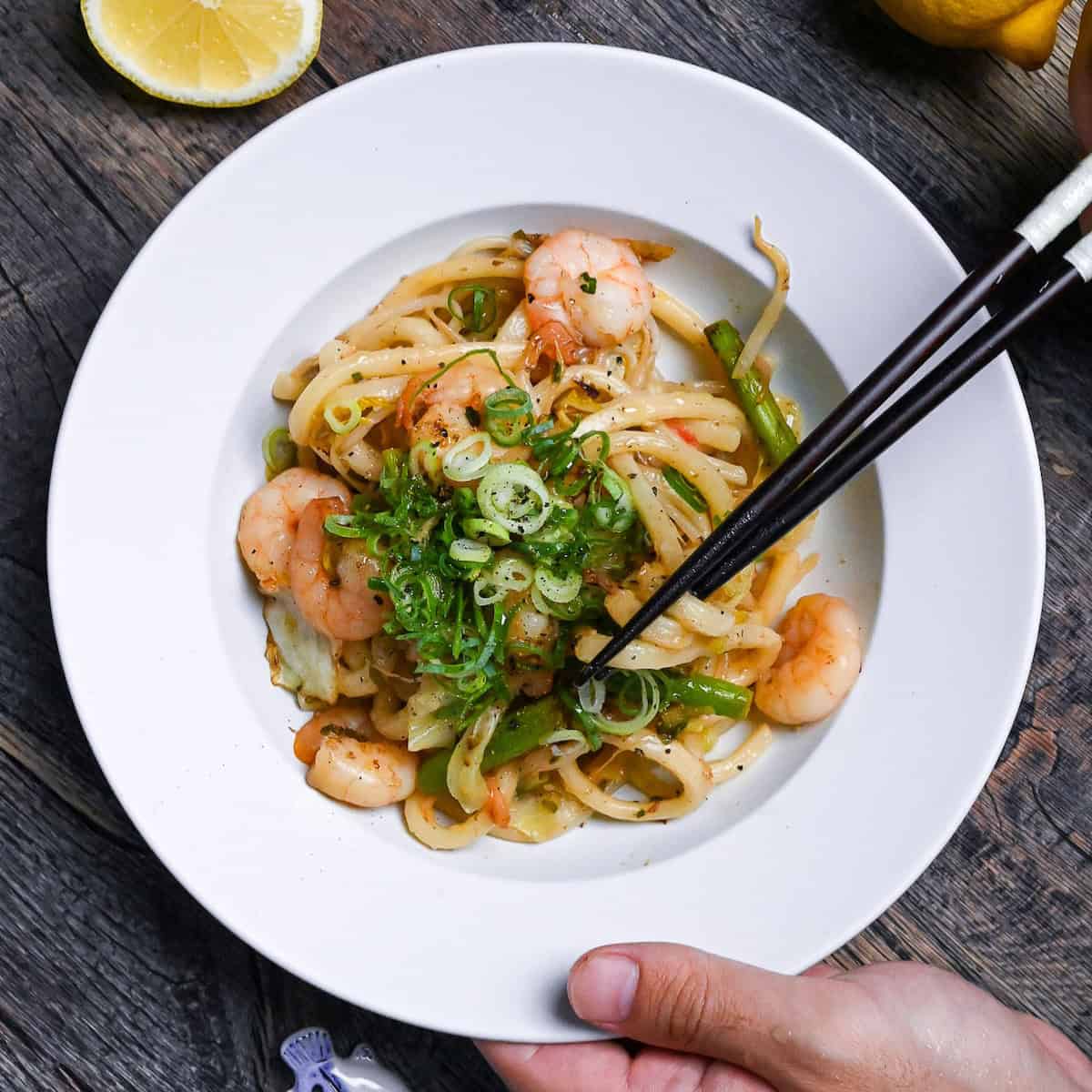
Shrimp Yaki Udon
Recipe Snapshot
- What is it? Citrusy shrimp & stir-fried udon with a salty-sesame kick.
- Flavor profile: Citrusy, Balanced, Lightly indulgent.
- Why you’ll love this recipe: You’ll love this recipe because it gives you a fast, flavor-packed dinner in under 20 minutes.
- Must-haves: Lemon, Large wok or pan, Udon noodles.
- Skill Level: Easy
- Suitable for Meal Prep? Partially.
Summarize & Save this content on:
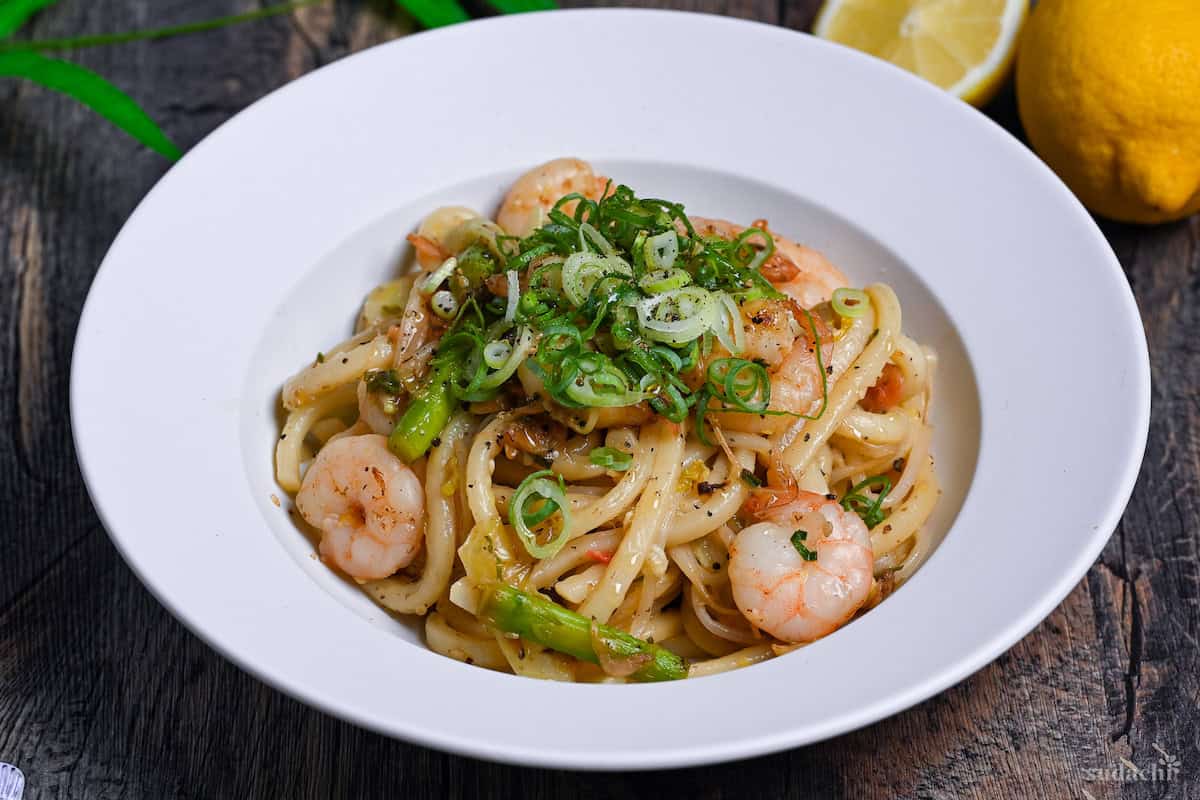
What is Yaki Udon?
Yaki udon (焼きうどん) is a Japanese stir-fry made with thick, chewy udon noodles, cooked quickly with vegetables, protein, and a savory sauce. The word “yaki (焼き)” simply means “grilled” or “cooked,” so you’ll see it in many Japanese dishes like yakiniku (grilled meat), yaki onigiri (grilled rice balls), yakitori (grilled chicken skewers), and yakimeshi (fried rice).
It’s closely related to yakisoba, which uses thinner wheat noodles. Same cooking style, similar seasoning, but the noodle swap changes the whole eating experience.
Shrimp Yaki Udon Ingredients
What You’ll Need for Shrimp Yaki Udon
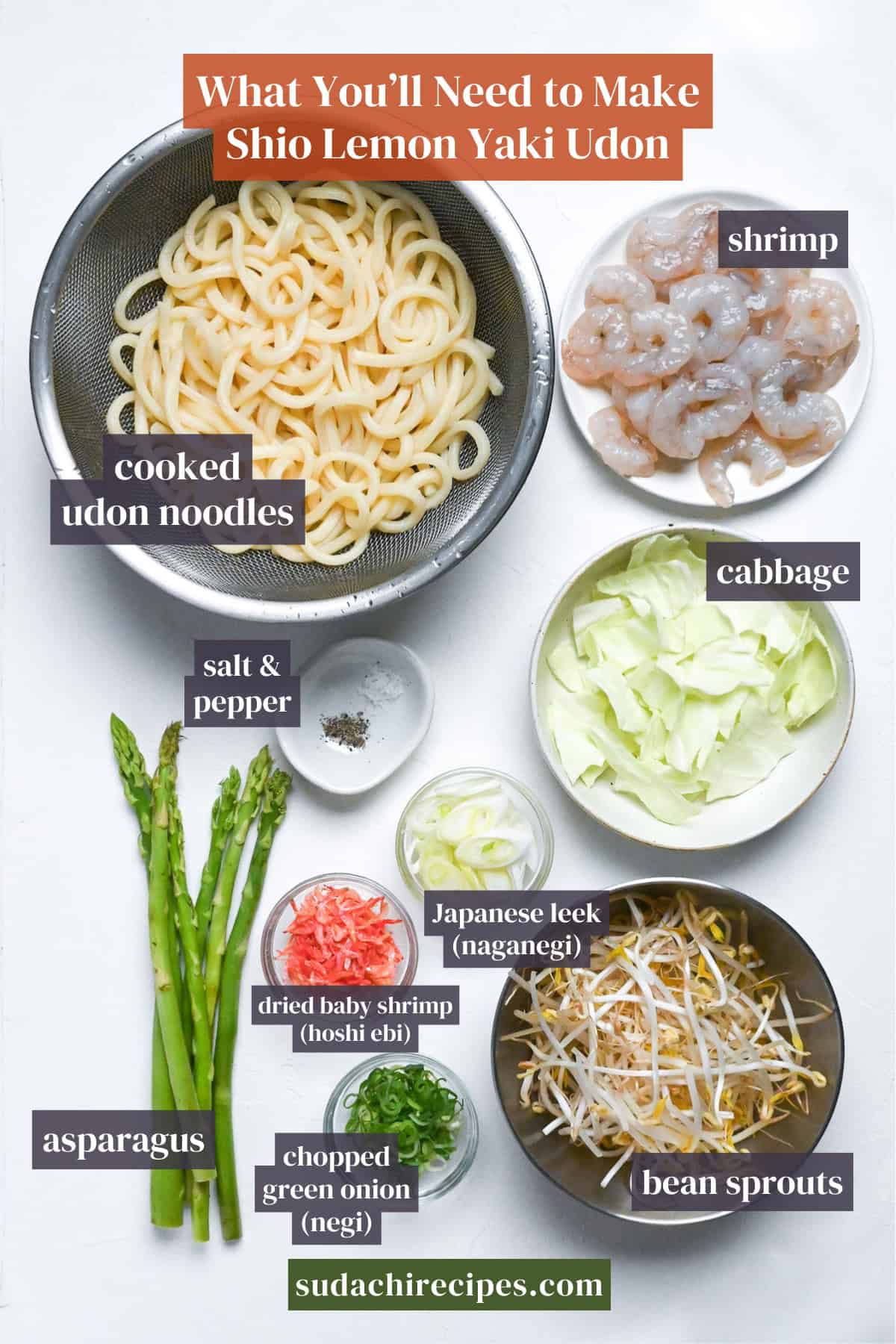
- Udon noodles: For yaki udon, boil or briefly blanch them (if using pre-boiled packaged ones) first so they stay bouncy in the pan. You’ll find dried udon at many supermarkets, and the soft refrigerated/frozen packs at Asian groceries. Weekend project? I also have a handmade udon recipe you can try.
- Green cabbage: Regular green cabbage works perfectly and adds a sweet crunch that balances the savory sauce.
- Dried baby shrimp: These add a briny, toasty pop of seafood umami. Look for them in the dried-seafood aisle at Asian markets. If you can’t locate them, you can also try adding depth by frying shrimp shells in oil like I did in my spicy seafood yaki udon recipe.
What You’ll Need for Salt Lemon Sauce
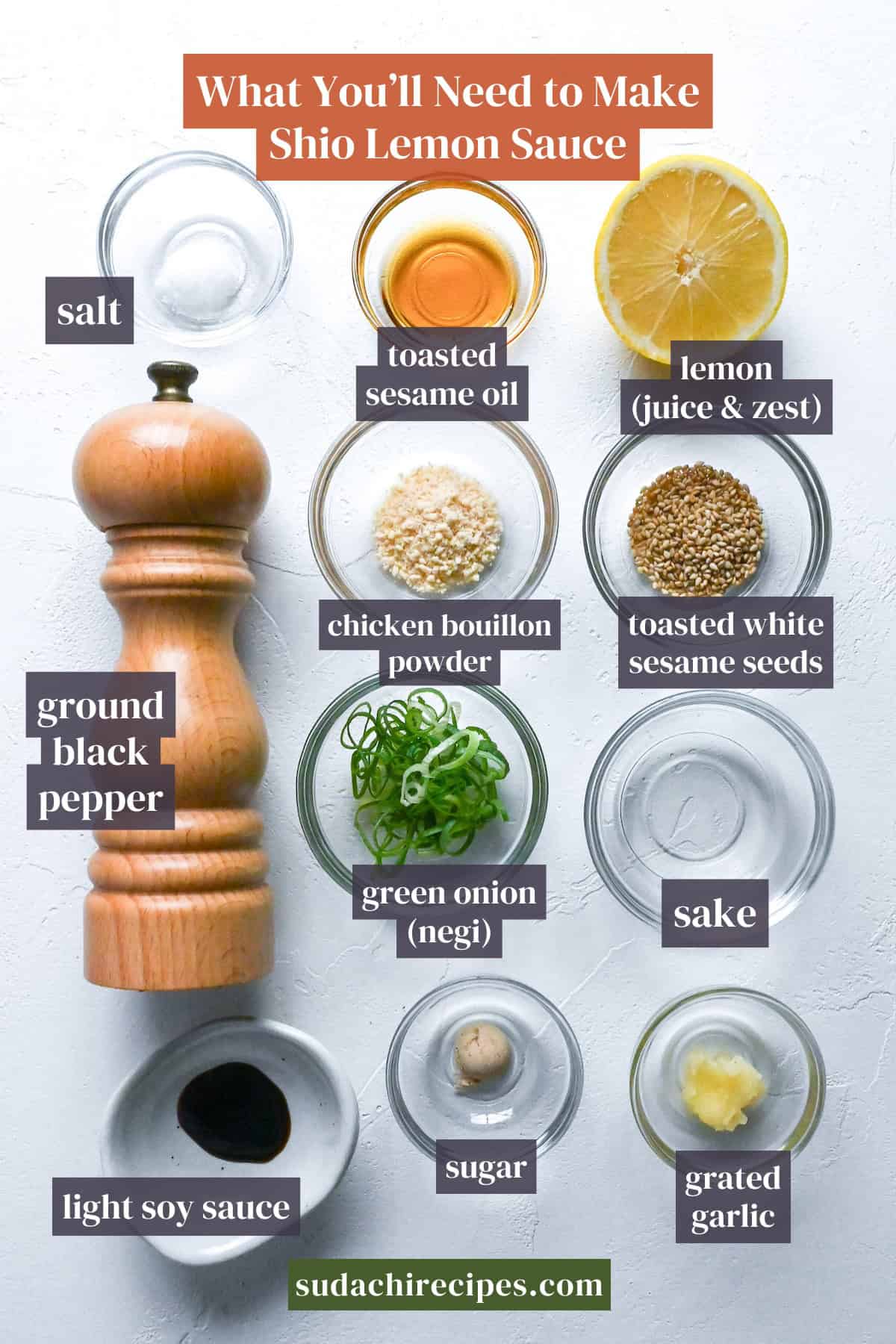
- Chicken bouillon powder: For the clearest flavor, use the Chinese-style version; you’ll find it at Asian groceries and widely online (brands such as Lee Kum Kee or Totole are common). No chicken powder on hand? Knorr granulated bouillon or Better Than Bouillon paste from big supermarkets works. Or go Japanese with dashi powder.
- Light soy sauce (usukuchi): A pale, salt-forward Japanese shoyu that keeps sauces bright without darkening the noodles. It’s often stocked at Asian groceries. If usukuchi isn’t handy, use regular Japanese soy sauce (koikuchi).
How to Make My Shrimp Yaki Udon
Before you start: make sure to deshell, devein, and clean your shrimp.
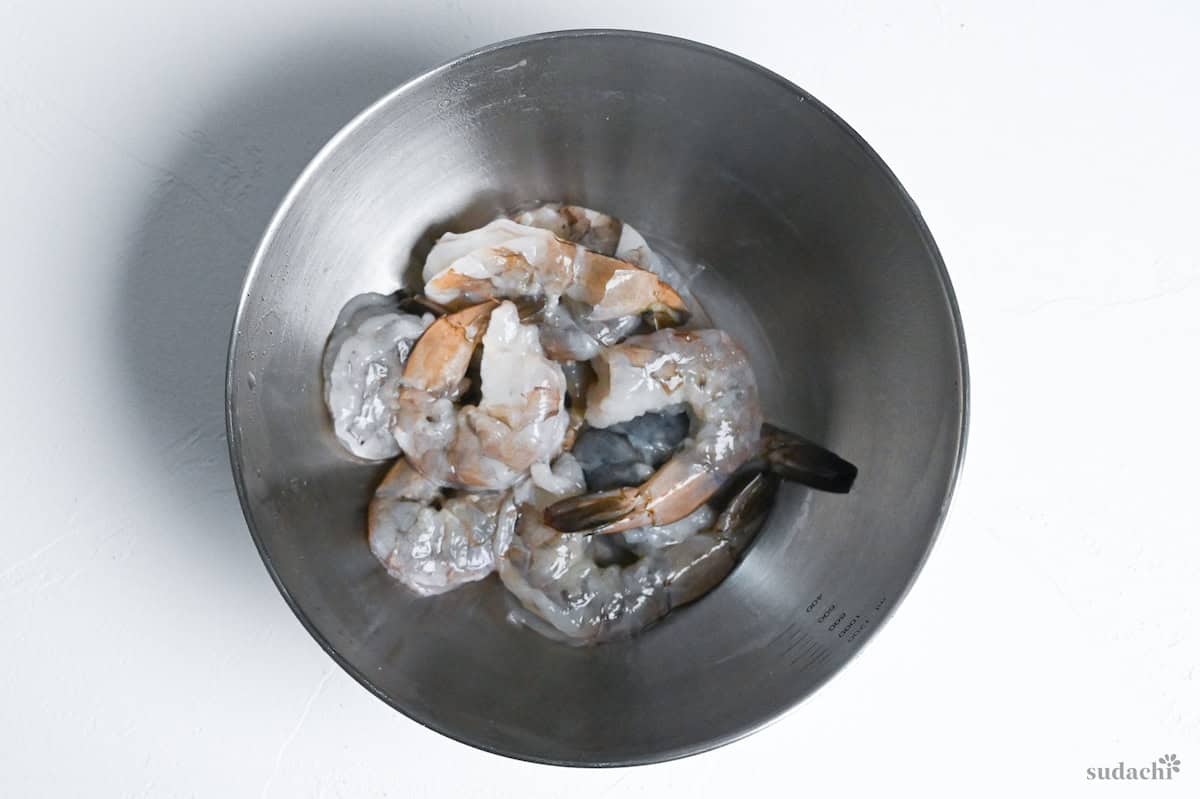
i. Whisk the shio-lemon stir-fry sauce in a small bowl until smooth. Pre-mixing prevents scrambling mid-cook and helps the sauce cling evenly so you can stir-fry fast.
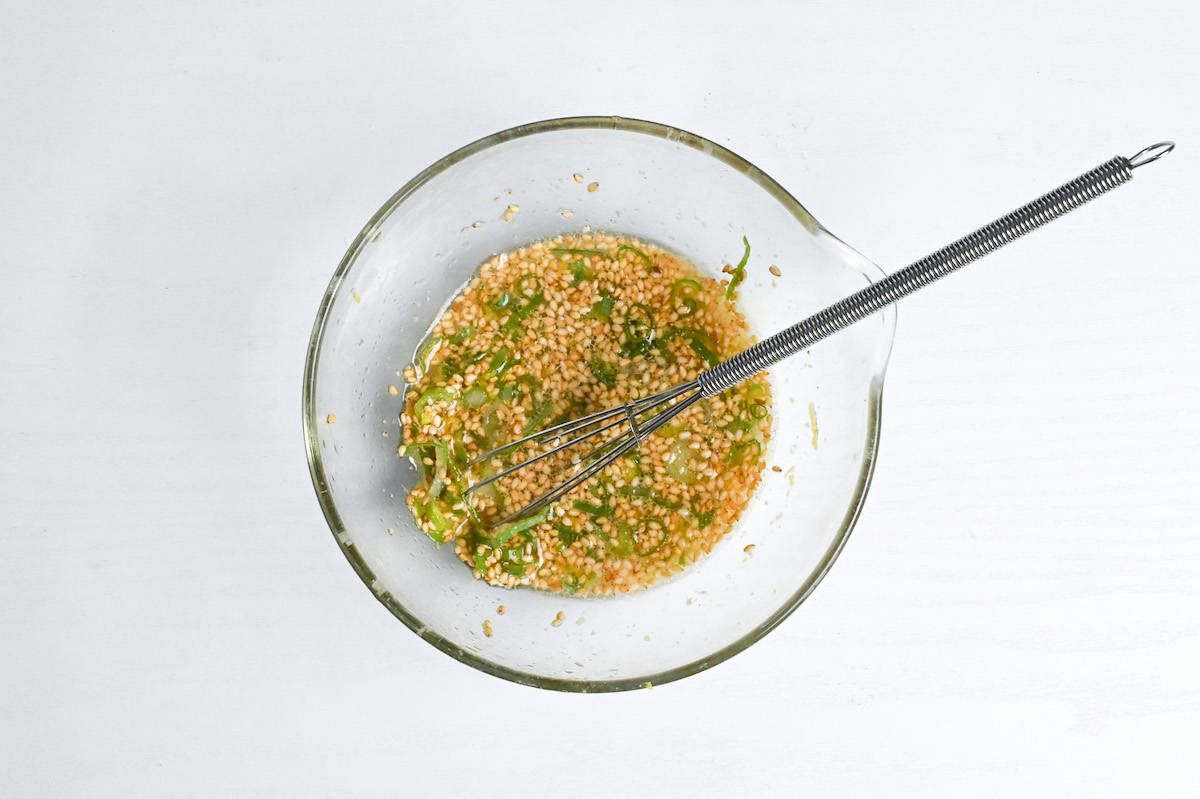
i. Set a wok over medium heat, add a thin film of neutral oil, then stir in dried baby shrimp and the white parts of Japanese leek. Stir-fry 45-60 seconds until the shrimp smell toasty. If anything scorches, reduce the heat slightly.
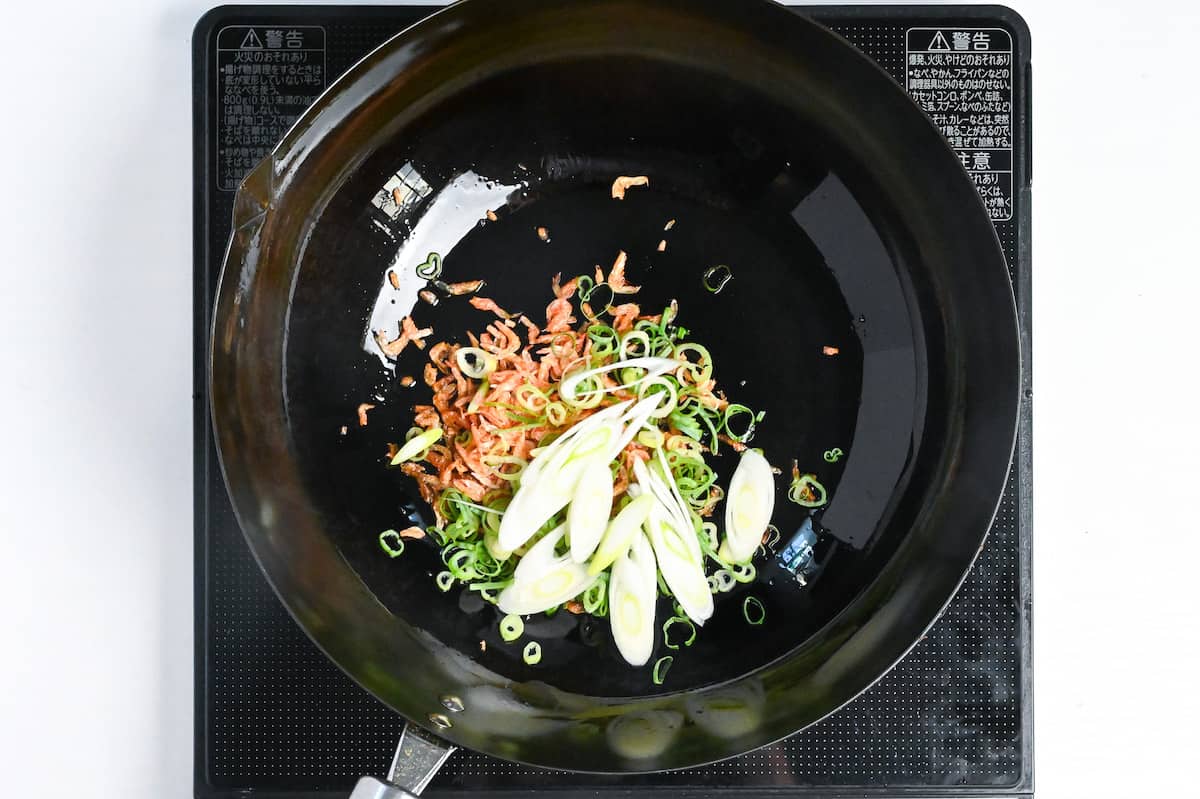
ii. Raise the heat to medium-high and add the shrimp and asparagus, season lightly and stir-fry until the shrimp turn pink and opaque, 2-3 minutes.
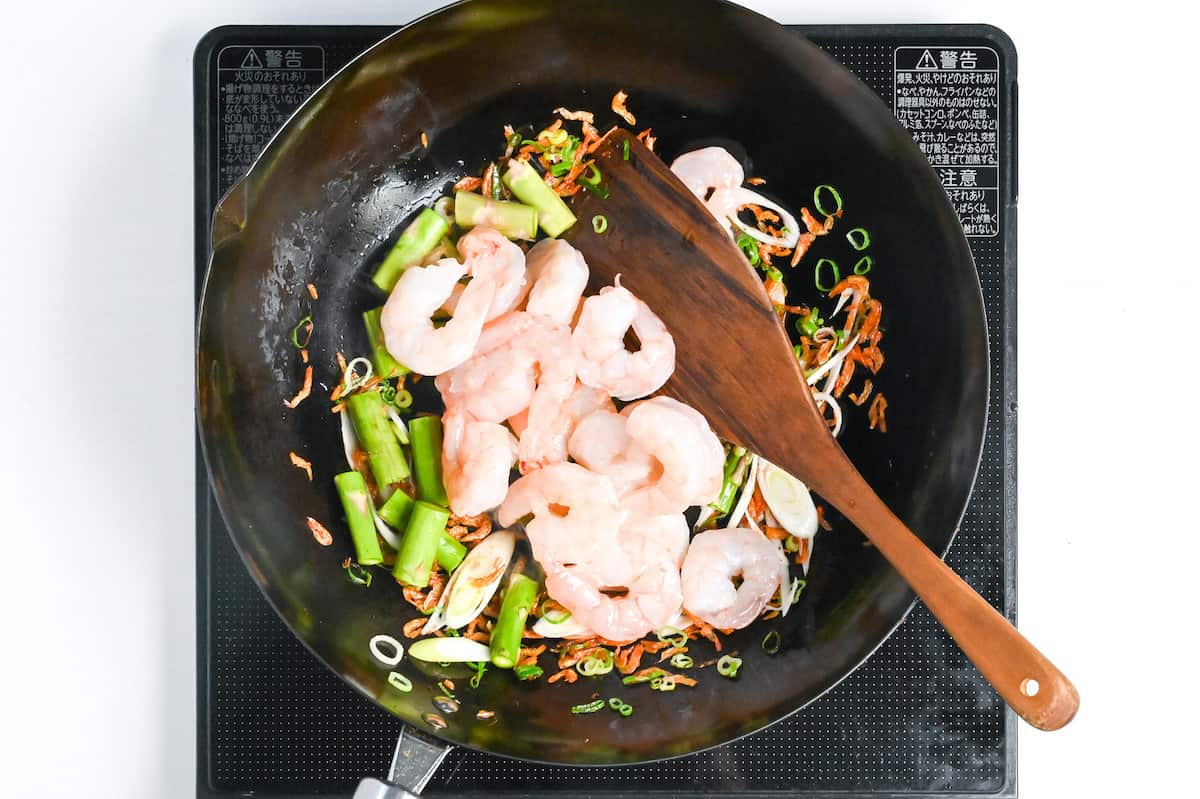
iii. Look for shrimp that curl into a loose “C” and feel springy. If your burner runs hot, pull the pan off heat for a few seconds to keep the shrimp juicy.
iv. Toss in the cabbage and bean sprouts and stir-fry 60-90 seconds until they’re bright and crisp-tender. Keep the food moving and avoid piling ingredients too high, which traps steam and softens texture.
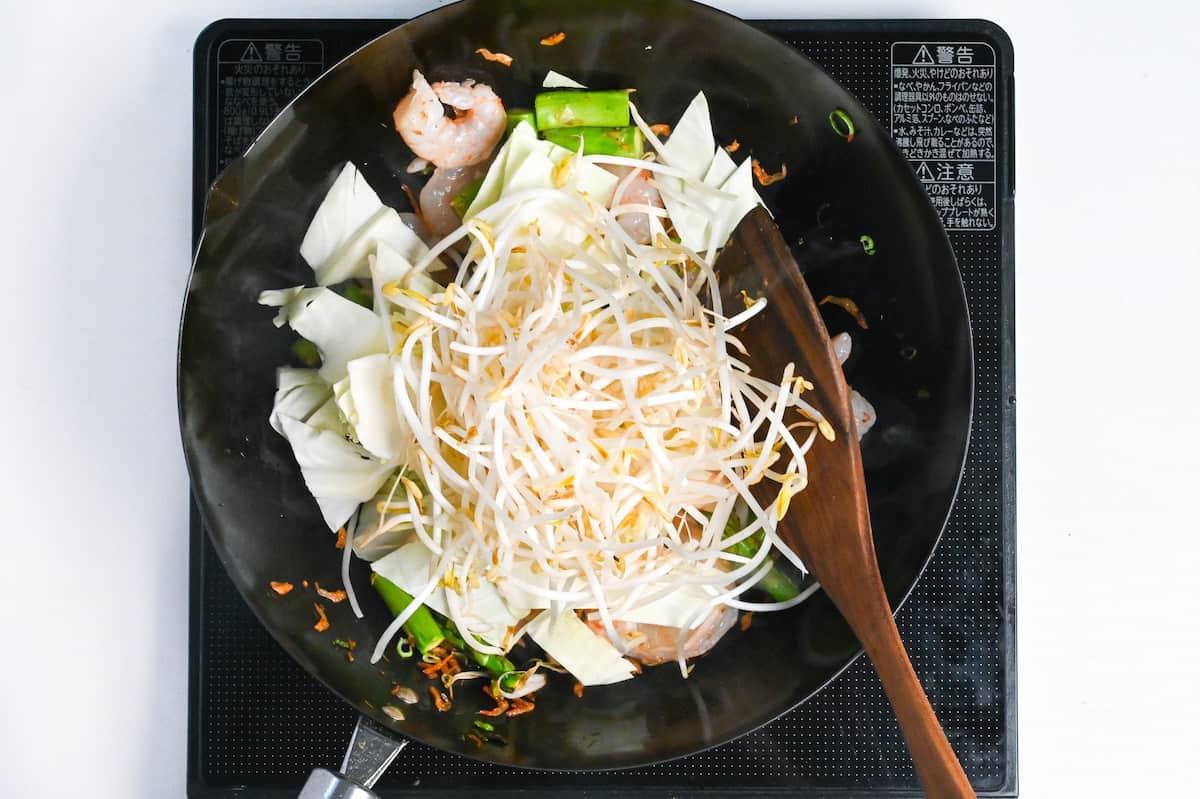
i. Push everything to one side. Add the udon to the empty space with a spoonful of water; let them steam 30-60 seconds, then separate gently with tongs or chopsticks to loosen strands without tearing.
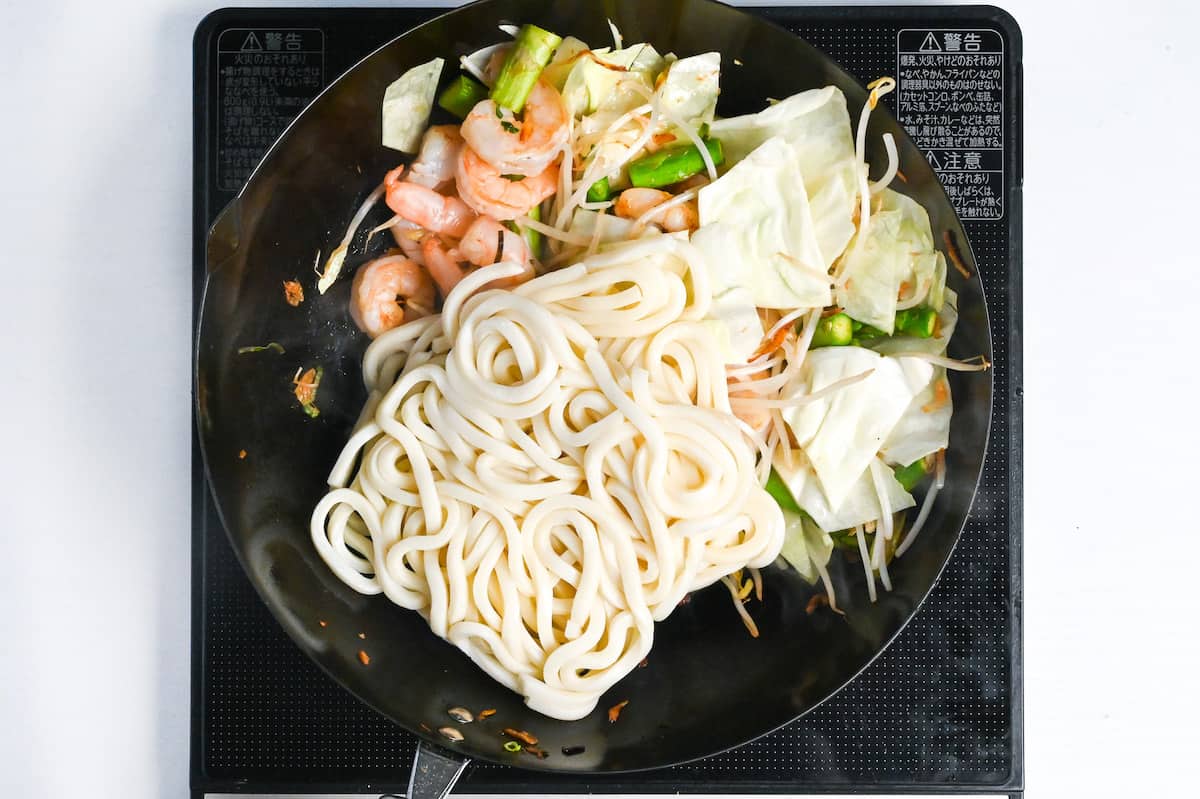
For best chew, use cooked fresh or frozen udon. They loosen quickly and stay bouncy in stir-fries, while some dried styles can turn pasty.
ii. Drizzle the sauce around the edge of the wok so it hits the hot metal first, then toss everything for 1-2 minutes until the noodles look glossy and evenly coated.
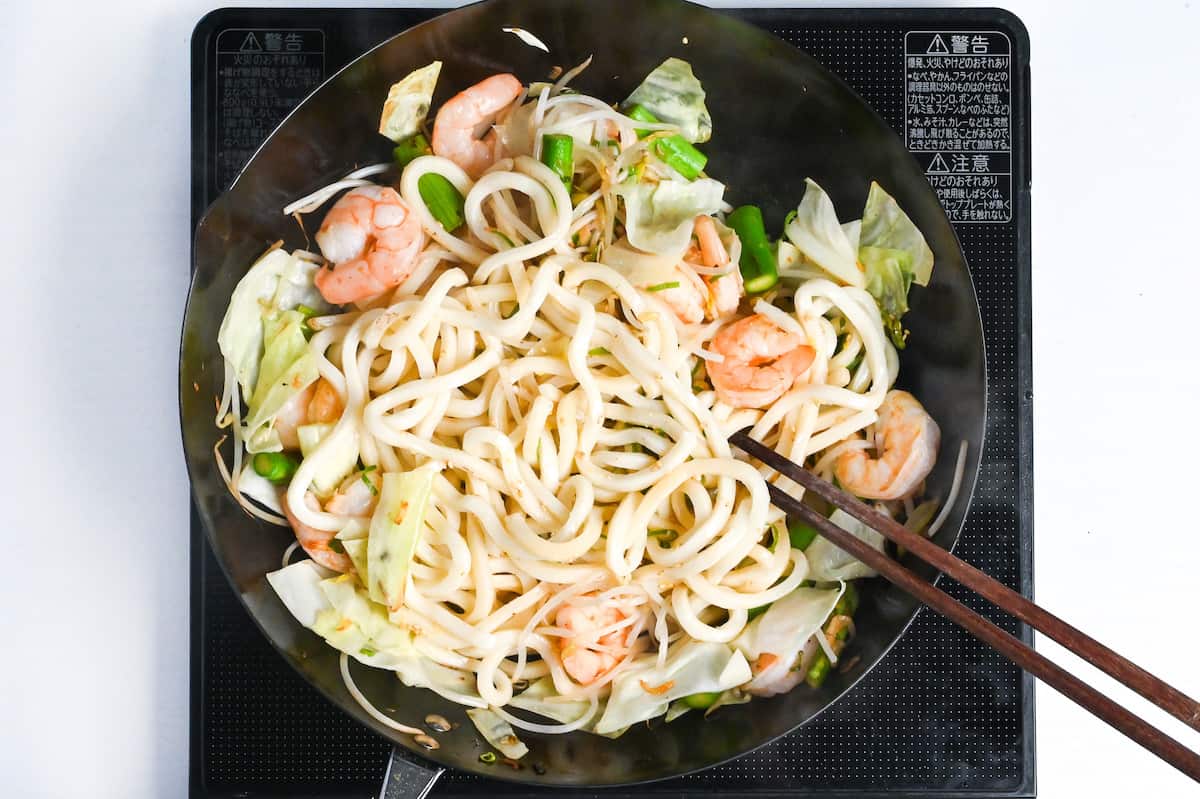
i. Turn off the heat, plate the noodles, and shower with chopped green onions, a drizzle of toasted sesame oil, and some ground black pepper.
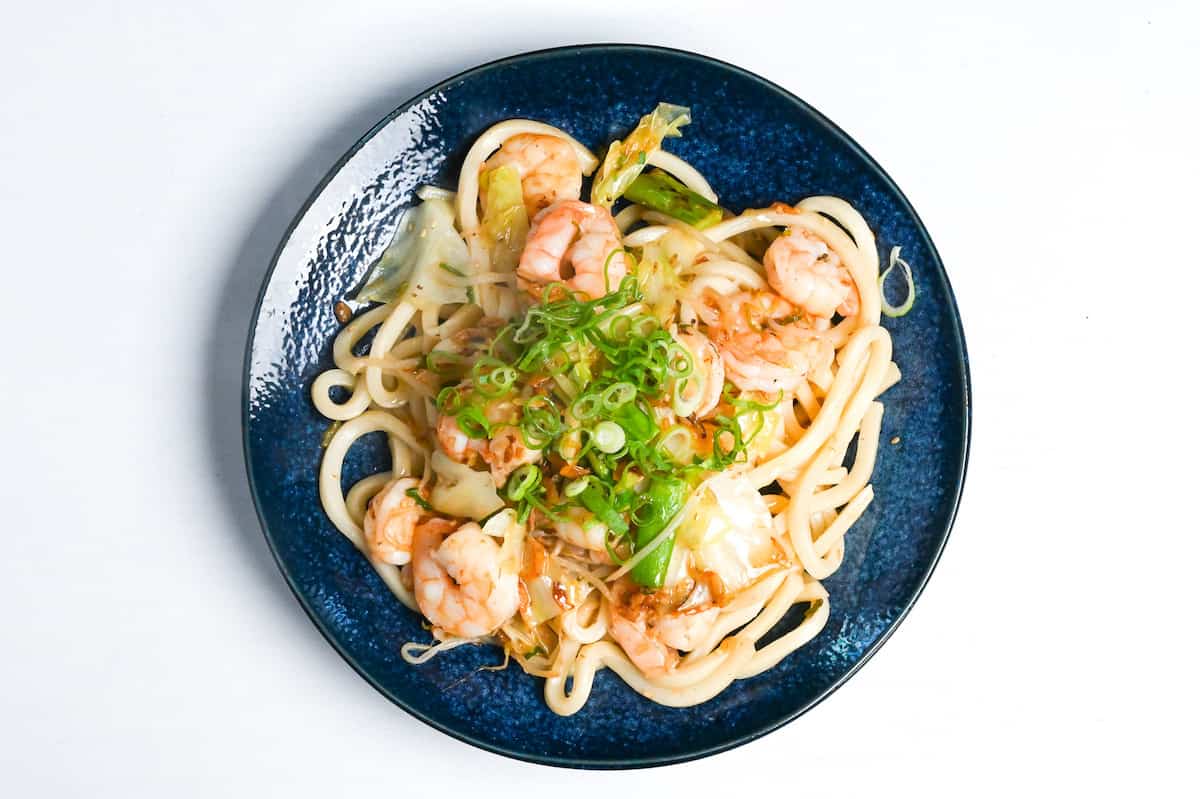
ii. Serve right away while the noodles are glossy and the vegetables still snap.

Essential Tips & Tricks
- Always whisk the sauce before you start cooking.
- When frying dried baby shrimp and leek, stop at “toasty and fragrant.”
- Add cabbage and bean sprouts at the end for just 1-2 minutes.
- If using dry udon, boil 1-2 minutes less than the time stated on the packaging and wash with cold water before you start the recipe. Drizzle with oil to prevent sticking if not using straight away.
With these simple tips in mind, you’re set for success every time you make shrimp yaki udon.
Storage & Meal Prep
Fridge: Transfer leftovers into an airtight container once cooled. Store in the refrigerator for up to 2 days.
Freezer: Not recommended.
Meal Prep: Sauce only up to 3 days ahead.
Reheating: Use a skillet or wok over medium heat with 1-2 tablespoons of water to loosen the noodles and revive moisture. Stir frequently until steaming hot.
What to Serve With This Recipe
- Miso Soup with Wakame and Tofu
- Spinach Ohitashi (Soy-Dashi Dressed Spinach)
- Japanese Potato Salad
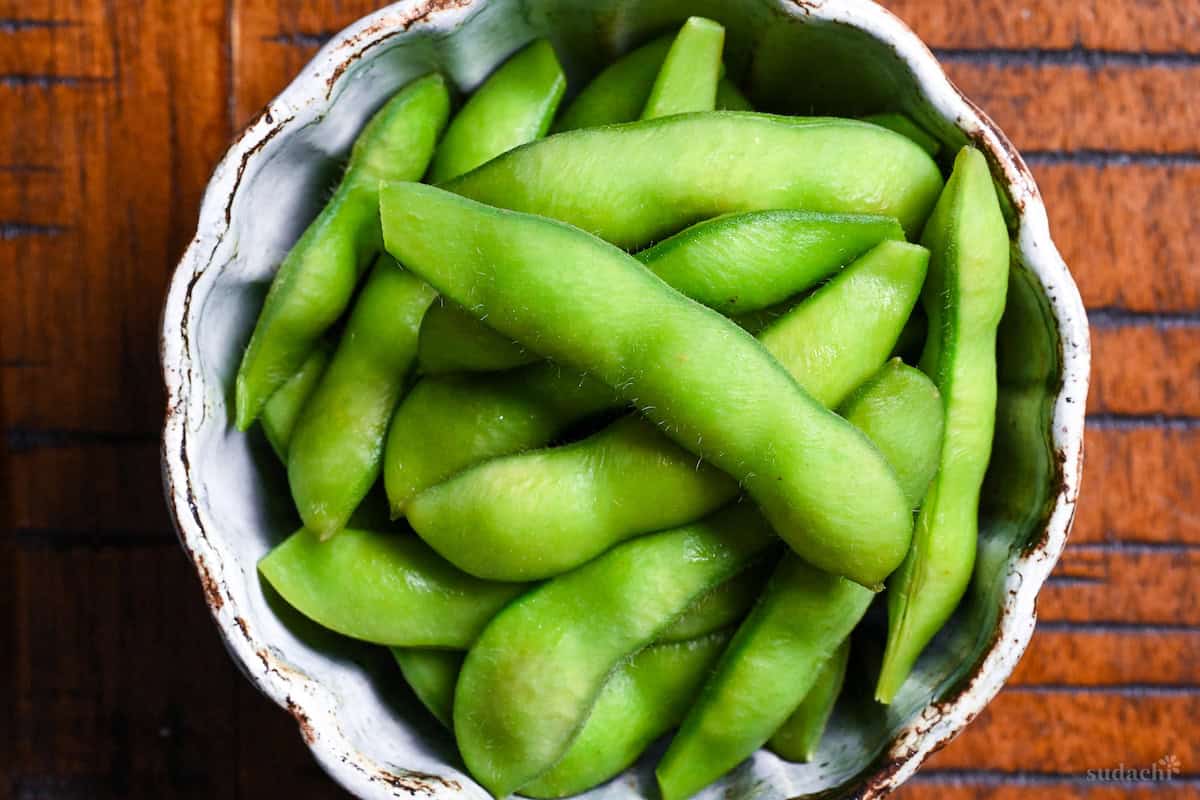
Shrimp Yaki Udon Q&A
Cooked fresh or frozen udon is best for stir-fries because they separate easily and stay chewy. Vacuum-packed preboiled noodles also work, but dip them briefly in hot water to loosen before cooking. Dried udon is less ideal but can be boiled one or two minutes less than the package states and washed with cold water before stir-frying in a pinch.
Not really, the noodles lose texture when stored. Instead, prep the sauce 2-3 days ahead and chop vegetables in advance. Cook the stir-fry fresh for the best result.
Reheat gently in a pan with 1-2 Tbsp water over medium heat, stirring often.
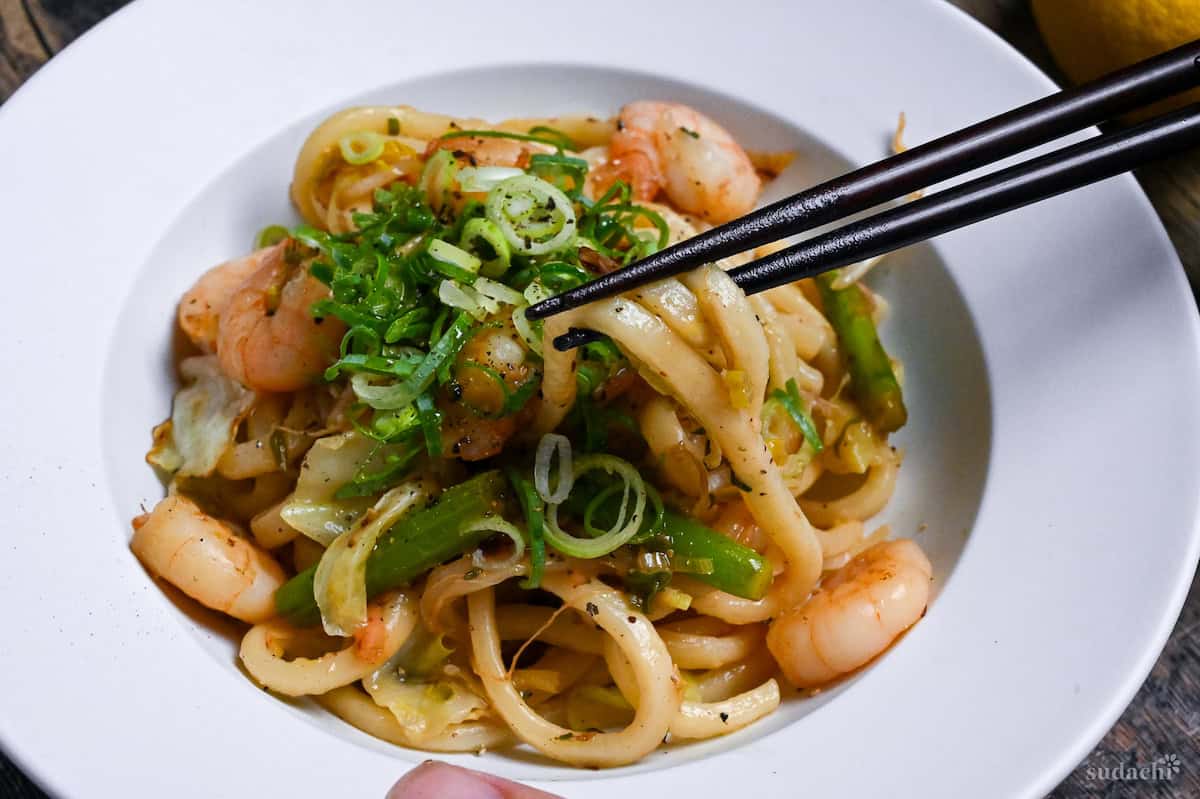
More Japanese Shrimp Recipes
Ready to explore authentic flavors? Discover the best Japanese shrimp recipes that showcase techniques and modern twists on classic dishes.
Did You Try This Recipe?
I would love to hear your thoughts!
💬 Leave a review and ⭐️ rating in the comments below. 📷 I also love to see your photos – submit them here!
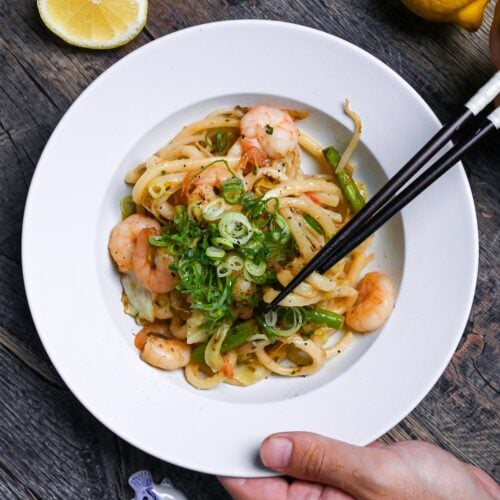
Shrimp Yaki Udon with Salt Lemon Sauce
Ingredients
Shio Lemon Sauce
- ½ tsp salt
- 1 pinch ground black pepper
- ¼ tsp sugar
- ½ tsp Japanese light soy sauce (usukuchi shoyu) or regular soy suace
- 1 tbsp sake or white wine
- ½ tsp grated garlic or garlic paste
- 1 tsp toasted sesame oil
- 1 lemon zest and juice
- 1 tsp Chinese-style chicken bouillon powder
- 1 tsp toasted white sesame seeds
- 1 tbsp finely chopped green onions green part
Shio Lemon Yaki Udon
- 2 tsp cooking oil
- 3 tbsp dried baby shrimp (hoshi ebi)
- 2 tbsp Japanese leek (naganegi) white part, finely sliced
- 200 g shrimp deshelled, deveined, and cleaned
- 100 g asparagus cut into 2cm pieces
- 1 pinch salt
- 50 g green cabbage roughly chopped
- 100 g bean sprouts rinse well
- 2 portions udon noodles pre-boiled
- finely chopped green onions to garnish
- ground black pepper to garnish
- toasted sesame oil optional garnish
My recommended brands of ingredients and seasonings can be found in my Japanese pantry guide.
Can’t find certain Japanese ingredients? See my substitution guide here.
Instructions
- Mix all the sauce ingredients, including the juice and zest of 1 lemon in a small bowl and set aside for later.

- Heat a wok on medium and add 2 tsp cooking oil. Add 3 tbsp dried baby shrimp (hoshi ebi) and 2 tbsp Japanese leek (naganegi) and fry for about 1 minute to flavor the oil.

- Increase the heat to medium high and add 200 g shrimp and 100 g asparagus , and sprinkle with 1 pinch salt. Fry until the shrimp turn opaque, about 2-3 minutes.

- Add 100 g bean sprouts and 50 g green cabbage and stir fry for 1-1 ½ minutes.

- Push all the ingredients to one side and add 2 portions udon noodles to the empty space in the pan. Add a splash of water and gently separate the noodles as they steam.

- Once the noodles are separated, pour the shio lemon sauce around the wok and stir fry everything together for 1-2 minutes.

- Dish up and sprinkle with finely chopped green onions, ground black pepper and a drizzle of toasted sesame oil. Enjoy!

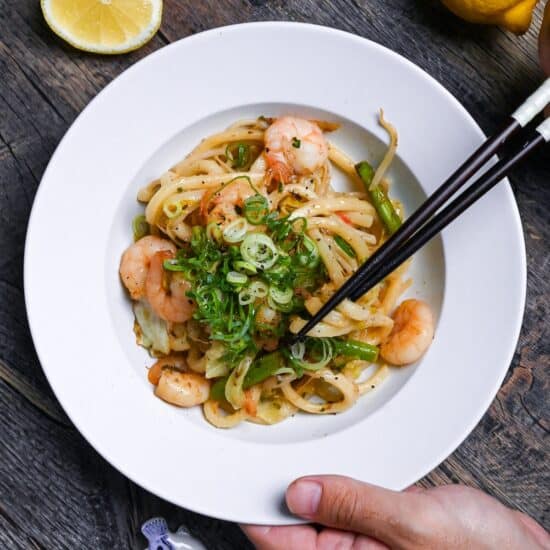


Had to make some minor adjustments based on what I had on hand (subbed marsala wine and vegan shrimp) , but still turned out great!
Hi Kalsey,
Thank you so much for trying this recipe! Love how you made it your own. Glad it turned out well!
Yuto